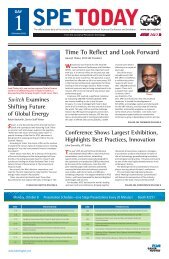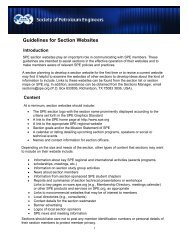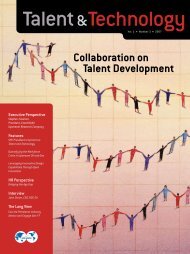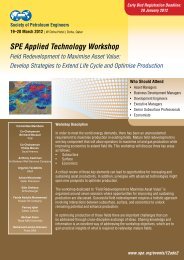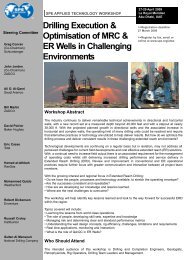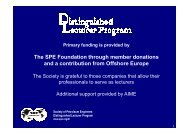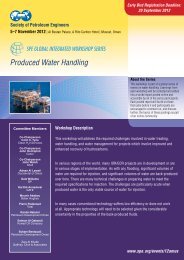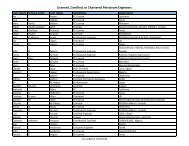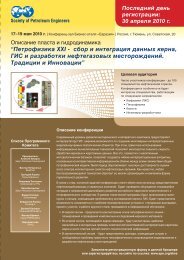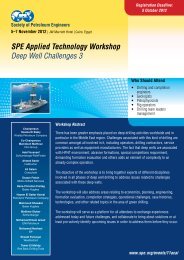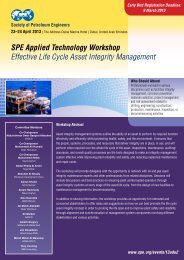Uncertainty Management and Risk Mitigation Over Asset Lifecycles
Uncertainty Management and Risk Mitigation Over Asset Lifecycles
Uncertainty Management and Risk Mitigation Over Asset Lifecycles
You also want an ePaper? Increase the reach of your titles
YUMPU automatically turns print PDFs into web optimized ePapers that Google loves.
28 November–1 December 2011<br />
Dubai, UAE<br />
<strong>Uncertainty</strong> <strong>Management</strong> <strong>and</strong> <strong>Risk</strong> <strong>Mitigation</strong> <strong>Over</strong> <strong>Asset</strong> <strong>Lifecycles</strong><br />
These exciting topics will be discussed in an open setting designed for optimal input from all participants.<br />
Session 1: Characterisation of Static <strong>Uncertainty</strong><br />
Session Managers: Mark Sykes, ExxonMobil<br />
W. Scott Meddaugh, Chevron<br />
<strong>Uncertainty</strong> is ubiquitous in the oil <strong>and</strong> gas industry. A careful consideration of<br />
uncertainty must be embraced throughout the lifecycle of a petroleum asset<br />
in order to fully characterise the range of possible geologic, production <strong>and</strong><br />
economic-performance outcomes. Static uncertainty, the range in possible oil or<br />
gas volumes in-place in the reservoir <strong>and</strong> their connectivity prior to production<br />
start-up, is the first uncertainty that petroleum companies must address. Failure<br />
to recognise, underst<strong>and</strong> <strong>and</strong> quantify static uncertainties renders attempts to<br />
control or harness uncertainties in subsequent elements of an asset’s lifecycle<br />
futile. Recent scientific literature <strong>and</strong> industry practices have refined the<br />
geological, conceptual <strong>and</strong> computational methodologies available for use in<br />
uncertainty assessment <strong>and</strong> mitigation. This session of the forum looks to critically<br />
examine these established approaches, <strong>and</strong> to discuss alternatives, which may be<br />
more effective at identifying <strong>and</strong> mitigating static uncertainty.<br />
Session 2: Characterisation of Dynamic <strong>Uncertainty</strong><br />
Session Managers: Ian Bryant, Schlumberger<br />
Paul van den Hoek, Shell<br />
Following evaluation of static uncertainty, it is necessary to evaluate uncertainty in<br />
the anticipated dynamic performance of an oil or gas asset. Early characterisation<br />
of a range of potential production profiles, often based on well tests, will<br />
control investment decisions in infrastructure <strong>and</strong> evaluation of alternative field<br />
development plans. Subsequently, surface measurements, downhole pressure<br />
<strong>and</strong> temperature measurements <strong>and</strong> repeat seismic surveys may be used to<br />
revise production forecasts. This session of the forum looks to evaluate how these<br />
measurements can be incorporated into contingency planning <strong>and</strong> optimisation<br />
over the lifecycle of assets.<br />
Session 3: Forecasting <strong>Risk</strong>s<br />
Session Managers: Marko Maucec, Halliburton<br />
Francois-Michel Colomar, IFP Middle<br />
East-Beicip-Franlab<br />
The presence of a large number of geological uncertainties <strong>and</strong> limited well<br />
data typically increase the challenges associated with forecasting hydrocarbon<br />
recovery. Traditionally, reservoir development decisions are based on a production<br />
forecast from a single history-matched reservoir model. Challenges mainly emerge<br />
in the characterisation of the main features of the reservoir uncertainty space to<br />
underst<strong>and</strong> uncertainties impact on production forecast, identify <strong>and</strong> mitigate risk.<br />
This in practice requires considering only a few (but which?) of the many probable<br />
realisations <strong>and</strong> scenarios.<br />
How can we quantify the uncertainty parameters range including structural<br />
framework, stratigraphic, facies <strong>and</strong> petrophysical model, properly rank their<br />
impact in order to define the critical factors <strong>and</strong> reduce their range for more<br />
accurate production forecast? Can we clearly identify state-of-the-art technologies<br />
for pre-screening geological models <strong>and</strong> sensitivity analyses in terms of usability<br />
Application Information<br />
Participants at SPE forums are selected by the Forum Steering Committee on the basis of ability to contribute to the<br />
discussion of the topic. Attendance is limited to maximise each person’s opportunity to contribute.<br />
Online: www.spe.org/events/11fsm2<br />
Mail: SPE Middle East FZ, North Africa <strong>and</strong> India, DMCC, PO Box 215959, Dubai, UAE<br />
Fax: +971.4.457.3164<br />
<strong>and</strong> industrial economic impact? When does such methodology become too<br />
sophisticated <strong>and</strong> advanced for routine use <strong>and</strong> how to stimulate a faster<br />
knowledge transfer from academia to industrial implementations?<br />
Session 4: Simplicity Versus Complexity<br />
Session Managers: Rik Sneep, South Rub Al Khali Company<br />
Segun Jebutu, Baker Hughes<br />
‘Simplicity is the ultimate sophistication’ according to Leonardo da Vinci. In the<br />
petroleum industry, the truth is that the level of complexity required to establish<br />
an economically acceptable value proposition can be quite a challenge to define.<br />
It will require a delicate balance between dynamic universal factors such as time,<br />
technology <strong>and</strong> integration potential.<br />
To harness the full benefit of the system, we must challenge all the fundamental<br />
assumptions for our simplistic model, <strong>and</strong> have a pre-determined process to guide<br />
us from the simplistic model to that optimal level of technical detail required to<br />
establish a maximum value proposition at an acceptable risk level.<br />
We will explore the fine balance between simple <strong>and</strong> complex <strong>and</strong> the associated<br />
merits <strong>and</strong> pitfalls covering amongst other topics:<br />
• How to define the required level of complexity to fully underst<strong>and</strong> the petroleum<br />
system?<br />
• Change of complexity requirements through the project lifecycle<br />
• <strong>Uncertainty</strong> as a function of data availability—the risk of creating ‘false<br />
certainties’<br />
‘Everything should be made as simple as possible, but not simpler…’ Einstein<br />
knew it all along.<br />
Session 5: Heuristic Approaches in Complex E&P<br />
<strong>Uncertainty</strong> <strong>and</strong> <strong>Risk</strong> <strong>Management</strong>: Advancing the<br />
Industry by Synergising Intelligent Data Mining <strong>and</strong><br />
High-Performance Computing<br />
Session Managers: Ralf Schulze-Riegert, SPT Group<br />
Moncef Attia, ADMA-OPCO<br />
Advances in high-performance computing allow reservoir engineers to run highly<br />
complex simulation models. Multiple reservoir simulation or process models<br />
representing predefined uncertainty distributions are processed concurrently on<br />
multiple computing units. Workflows for estimation of prediction uncertainties are<br />
supported by generating large amount of information, which are mostly condensed<br />
to expected means, variances etc.<br />
Result presentation <strong>and</strong> the quality of data analysis are always critical. Data mining<br />
<strong>and</strong> smart data analysis techniques become even more important as the amount<br />
of information increases. At the same time heuristic approaches <strong>and</strong> expert<br />
knowledge remain a key success factor for any reservoir study supporting field<br />
development projects.<br />
Application Deadline: 15 September 2011<br />
An electronic version of the printed application form is available for downloading <strong>and</strong> printing at www.spe.org/events/11fsm2.<br />
You may also contact SPE at +971.4.457.5800 or sjubran@spe.org to receive a printed application form via mail, fax or email.




